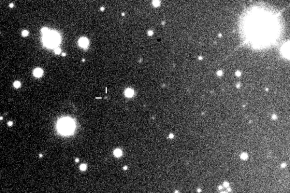Orthosie (moon)
Appearance
(Redirected from S/2001 J 9)
 Discovery image of Orthosie by the Canada-France-Hawaii Telescope in December 2001 | |
| Discovery [1] | |
|---|---|
| Discovered by | Scott S. Sheppard David C. Jewitt Yanga R. Fernandez |
| Discovery site | Mauna Kea Observatory |
| Discovery date | 11 December 2001 |
| Designations | |
Designation | Jupiter XXXV |
| Pronunciation | /ɔːrˈθoʊziː/ |
Named after | Ορθωσία Orthōsia |
| S/2001 J 9 | |
| Adjectives | Orthosian[2] /ɔːrˈθoʊʒiən/[3] |
| Orbital characteristics [4] | |
| Epoch 17 December 2020 (JD 2459200.5) | |
| Observation arc | 16.29 yr (5,949 days) |
| 0.1415163 AU (21,170,540 km) | |
| Eccentricity | 0.4837243 |
| –629.29 d | |
| 333.61997° | |
| 0° 34m 19.449s / day | |
| Inclination | 148.48740° (to ecliptic) |
| 287.90005° | |
| 261.21085° | |
| Satellite of | Jupiter |
| Group | Ananke group |
| Physical characteristics[5] | |
| 2 km | |
| Albedo | 0.04 (assumed) |
| 23.1[6] | |
| 16.6[4] | |
Orthosie /ɔːrˈθoʊziː/, also known as Jupiter XXXV, is a natural satellite of Jupiter. It was discovered by a team of astronomers from the University of Hawaii led by Scott S. Sheppard in 2001, and given the temporary designation S/2001 J 9.[7][1]
Orthosie is about 2 kilometres in diameter, and orbits Jupiter at an average distance of 21,075,662 km in 625.07 days, at an inclination of 146.46° to the ecliptic (143° to Jupiter's equator), in a retrograde direction and with an eccentricity of 0.3376.[8]
It was named in August 2003 after Orthosie, the Greek goddess of prosperity and one of the Horae.[9] The Horae (Hours) were daughters of Zeus and Themis.
Orthosie belongs to the Ananke group.
References
[edit]- ^ a b Brian G. Marsden (15 May 2003). "MPEC 2002-J54: Eleven New Satellites of Jupiter". International Astronomical Union Minor Planet Center.
- ^ William Beloe (1821) Herodotus, translated from the Greek, with notes, vol. 2, p. 451
- ^ per 'Orthosia' in Noah Webster (1884) A Practical Dictionary of the English Language
- ^ a b "M.P.C. 127087" (PDF). Minor Planet Circular. Minor Planet Center. 17 November 2020.
- ^ "Planetary Satellite Physical Parameters". Jet Propulsion Laboratory. 19 February 2015. Retrieved 26 November 2020.
- ^ Sheppard, Scott. "Scott S. Sheppard - Jupiter Moons". Department of Terrestrial Magnetism. Carnegie Institution for Science. Retrieved 26 November 2020.
- ^ Daniel W. E. Green (16 May 2002). "IAUC 7900: Satellites of Jupiter". International Astronomical Union.
- ^ "Ephemeris of Orthosie, Epoch 2017 Feb. 16.0 TT = JDT 2457800.5". MPC. Retrieved 13 August 2018.
- ^ Daniel W. E. Green (8 August 2003). "IAUC 8177: Satellites of Jupiter, Saturn, Uranus". International Astronomical Union.
